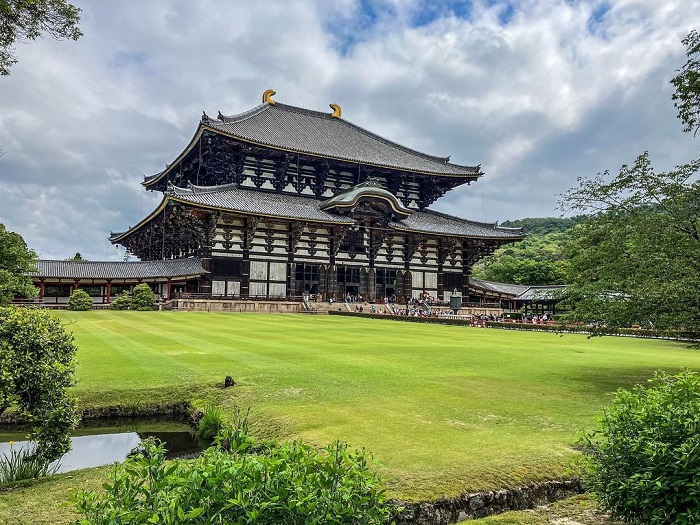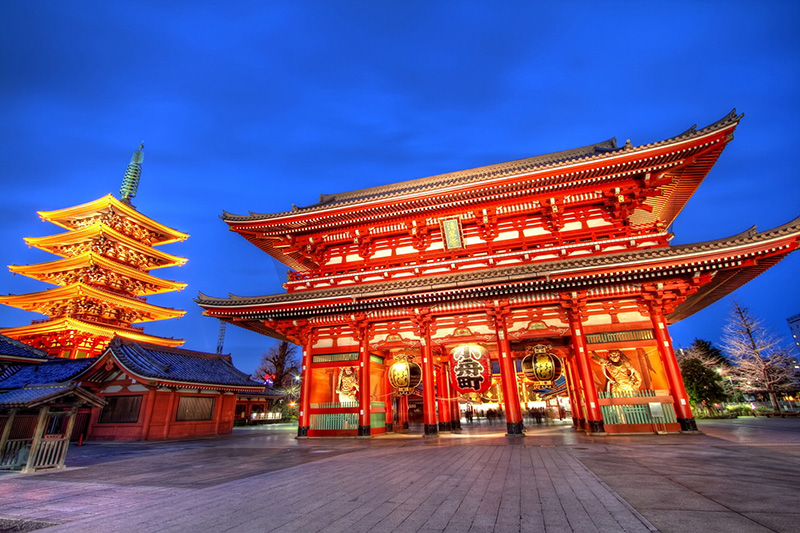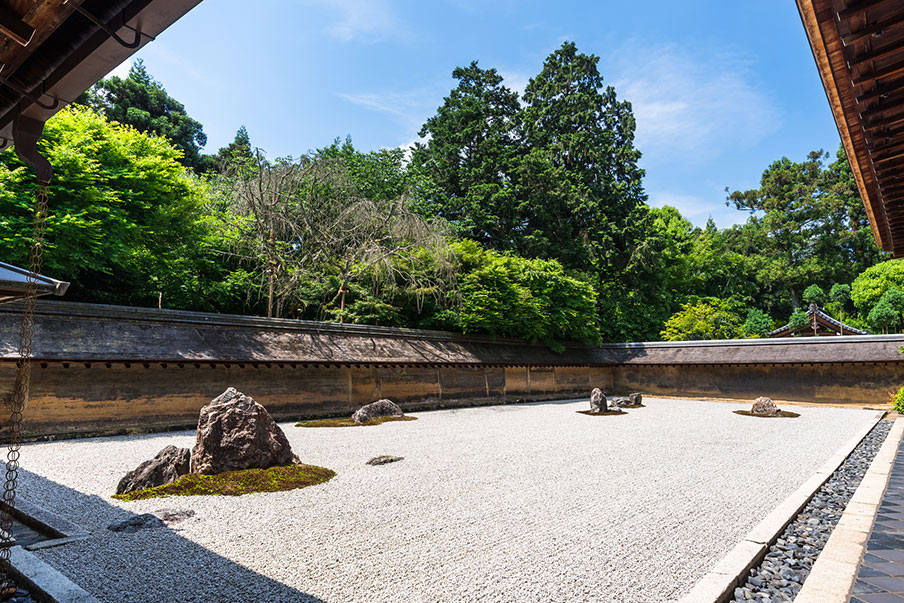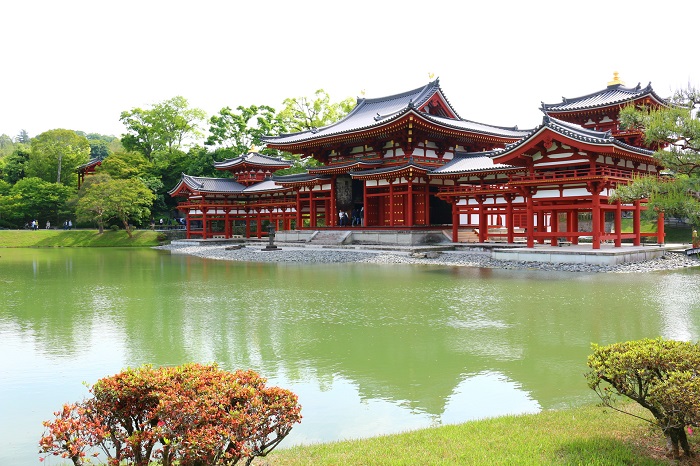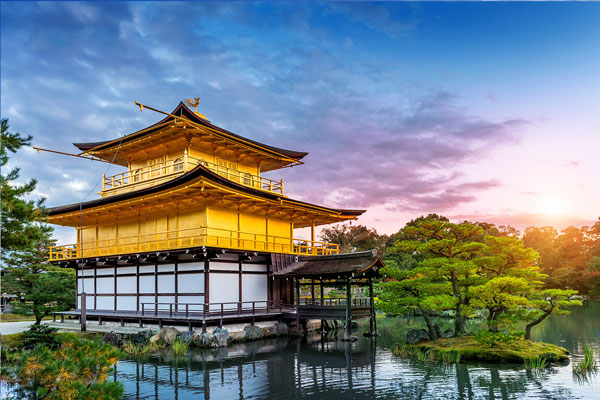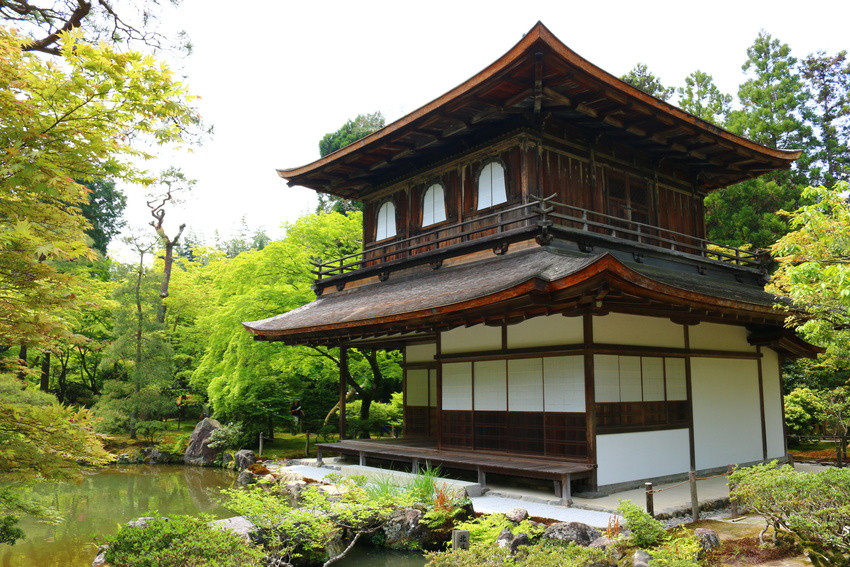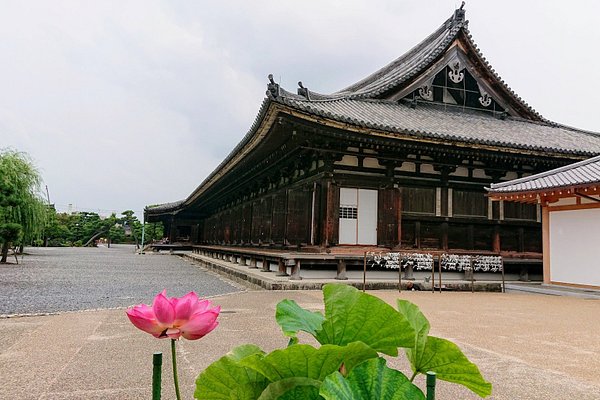Much like its counterparts in other Asian nations, Buddhism plays a pivotal role in spiritual and cultural fabric of Japan. Japan stands as a repository of ancient Buddhist architectural marvels, some spanning centuries or even millennia. These edifices have borne witness to the nation’s numerous historical ebbs and flows.
These venerable Japanese temples, with their unique and intricate designs, not only underscore the nation’s profound cultural and religious heritage but also beckon international travelers, eager to immerse in their historical splendor. As you traverse its varied landscapes, from bustling urban centers to tranquil countryside, these temples emerge as sanctuaries of serenity, art and spirituality.
In this article, LotusBuddhas will introduce to you 10 famous and beautiful Buddhist temples in Japan, spiritual tourist destinations that attract tourists to this land of cherry blossoms.
1. Tōdai-ji Temple
Tōdai-ji Temple, strategically located in Nara, Japan, is an architectural and cultural marvel that draws tourists from all over the world. Recognized as both a UNESCO World Heritage site and a National Treasure of Japan, Tōdai-ji embodies Japan’s rich historical legacy and the profound impact of Buddhism on its cultural development.
A major allure of Tōdai-ji is the Daibutsuden (Great Buddha Hall), one of the world’s largest wooden structures. Within this hall, you’ll be met with the awe-inspiring sight of the Daibutsu, the colossal bronze statue of the Buddha Vairocana. This iconic statue, standing at a staggering height of nearly 15 meters and weighing around 500 tons, is a testament to the sophistication of ancient Japanese metallurgy and craftsmanship.
However, the appeal of Tōdai-ji extends beyond its impressive structures. As you wander the vast temple grounds, you’ll encounter lush gardens, serene ponds, and smaller subsidiary temples and shrines, each narrating its unique chapter of Japanese history. The Nigatsu-dō and Sangatsu-dō halls, for instance, are renowned for their intricate woodwork and the antique Buddhist statues they shelter.
For those keen on immersion, Tōdai-ji provides interactive experiences. You can partake in Buddhist rituals, engage in meditation sessions, or attend lectures on Buddhist teachings. Moreover, a unique challenge awaits at one of the temple’s pillars in the Daibutsuden. Here, you’ll find a hole the same size as the Great Buddha’s nostril. It is believed that those who can squeeze through this opening will be blessed with enlightenment in their next life.
Furthermore, the temple’s location in Nara Park means that you’ll often encounter the park’s famous free-roaming deer, believed to be messengers of the gods in Shinto belief. These gentle creatures add a whimsical touch to your temple visit.
2. Kiyomizu-dera Temple
Kiyomizu-dera, nestled in the picturesque city of Kyoto, stands as an epitome of Japan’s unparalleled architectural prowess and its deep-seated spiritual heritage. A UNESCO World Heritage site and one of the Historic Monuments of Ancient Kyoto, Kiyomizu-dera serves as a beacon, drawing countless tourists eager to bask in its magnificence and unravel the tales it preserves.
One of the temple’s most striking features is its expansive wooden terrace, supported by towering pillars, offering panoramic views of the city enveloped in seasonal beauty. From cherry blossoms in spring to vibrant autumn foliage, the changing seasons paint a mesmerizing backdrop, compelling you to pause and soak in the moment.
The temple’s very name, “Kiyomizu,” translates to “pure water,” and aptly so. At the heart of the complex is the Otowa Waterfall, where three separate streams of water cascade. You, like many visitors, can partake in the ritual of capturing the water using cups attached to long poles, each stream believed to confer benefits in either longevity, academic success, or love.
As you traverse the temple grounds, Jishu Shrine awaits, dedicated to the deity of love and matchmaking. Here, you’re presented with a challenge — to walk between two stones placed 18 meters apart with your eyes closed. Successfully navigating this path is believed to fortify one’s romantic endeavors.
Your experience at Kiyomizu-dera isn’t confined to its buildings and rituals. The approach to the temple, lined with quaint shops, offers you a sensory journey. You can savor traditional Kyoto specialties, buy handcrafted souvenirs, and even don the vibrant kimonos available for rent.
It’s not just a temple but a space where you engage with Japanese culture, history, and spirituality on a profound level. Your journey here extends beyond sightseeing, drawing you into introspective moments, traditional practices, and the boundless beauty of Japan’s cultural tapestry.
3. Senso-ji Temple
Senso-ji, an iconic edifice in Tokyo’s historic Asakusa district, is Tokyo’s oldest and arguably most venerated temple. Dating back to the 7th century, this Buddhist temple’s profound historical significance and captivating beauty have cemented its status as a must-visit destination for travelers.
Upon your approach to Senso-ji, the majestic Kaminarimon or “Thunder Gate” stands as a sentinel, guarding the temple’s entrance. Adorned with a colossal red paper lantern, this gate serves as a prelude to the temple’s grandeur and beckons visitors to delve deeper into the temple grounds.
Navigating from Kaminarimon, you’ll find yourself traversing Nakamise-dori, a bustling shopping street replete with traditional stalls. This stretch, spanning over 200 meters, offers you a unique opportunity to immerse yourself in Japanese culture. From artisan crafts, traditional snacks like ningyo-yaki (doll-shaped cakes filled with sweet red bean paste), to the intricately designed yukatas and souvenirs, every item tells a story.
At the end of this vibrant alleyway, the temple’s main hall and a five-story pagoda emerge, both embodying a blend of historical gravitas and architectural splendor. While the main hall is a focal point for prayers, it also houses a statue of Kannon, the goddess of mercy, to whom temple is dedicated. Although the statue is not on public display, just the knowledge of its presence adds a layer of reverence to your visit.
The temple grounds further encompass other smaller shrines and beautifully landscaped gardens, inviting contemplation and offering spots of tranquility amidst the city’s hustle.
Beyond its architectural and historical allure, Senso-ji is also a hub for cultural festivities. Depending on when you visit, you might be fortunate to witness vibrant events such as the Sanja Matsuri or the Hozuki Ichi.
A visit here offers you a tapestry of experiences – from understanding the religious practices of Japan and indulging in traditional shopping to simply basking in the temple’s serenity. Every corner whispers tales from the past, making your journey through Senso-ji a walk through the annals of Tokyo’s rich heritage.
4. Ryoan-ji Temple
Ryoan-ji, situated in the culturally rich city of Kyoto, is a Zen Buddhist temple renowned for its enigmatic and iconic rock garden. As a UNESCO World Heritage site, this temple epitomizes the height of Zen aesthetics and offers a sublime representation of Japan’s philosophical and artistic inclinations.
Upon your entry into Ryoan-ji, the foremost attraction you’ll encounter is its karesansui, or dry landscape garden. This garden, measuring 30 meters from east to west and 10 meters from south to north, is an austere composition of fifteen carefully arranged rocks on a bed of fine white gravel, raked daily to perfection. The garden’s unique layout ensures that, from any vantage point, only fourteen of the fifteen rocks are visible. It’s posited that attaining a view of the fifteenth rock signifies a moment of enlightenment. As you ponder the garden’s layout and its deeper meanings, the garden invites introspection, urging you to contemplate the essence of existence and the intricacies of perception.
Beyond the rock garden, Ryoan-ji’s grounds are an embodiment of tranquility. The Kyoyochi Pond, predating the temple itself, presents a picturesque scene with its mirror-like waters reflecting the seasonal beauty of surrounding trees and the hills beyond. As you stroll around this pond, the sounds of chirping birds and gentle breezes can offer a meditative experience.
The temple complex also houses the Tsukubai, a stone water basin for ritual purification. The basin bears an inscription, which when translated, underscores the Zen principle of humility: “I learn only to be contented.” Ryoan-ji is not just a sight to behold but an experience to be felt. The temple’s minimalistic design and natural beauty make it a retreat for the soul.
5. Byōdō-in Temple
Byōdō-in, gracefully positioned in the historic city of Uji in Kyoto Prefecture, is a resplendent representation of Japan’s Heian period architecture and the enduring influence of Buddhism on its cultural fabric. Inscribed as a UNESCO World Heritage site, this temple stands not just as an architectural marvel but as a beacon of Japan’s rich historical and spiritual heritage.
Central to Byōdō-in’s allure is Phoenix Hall, named for its likeness to a bird taking flight, with its gracefully outstretched wings. As you approach, the hall’s stunning façade, replete with intricate carvings and capped with a pair of phoenix statues, evokes a sense of timelessness. Phoenix Hall’s interior is equally captivating, housing a magnificent statue of the Amida Buddha, surrounded by a host of celestial attendants in delicate relief.
Surrounding the Phoenix Hall, the temple’s gardens exemplify pure Japanese aesthetics. Designed to capture nature’s transient beauty across seasons, the pond in front reflects the hall’s image, creating an ethereal scene reminiscent of the Western Pure Land, a Buddhist paradise. As you traverse the garden paths, the interplay of light, water, and architecture can transport you to realms of tranquility and reflection.
Further elevating Byōdō-in’s significance is its presence on the Japanese 10-yen coin, attesting to its cultural and historical importance in the national psyche.
Beyond its architectural and spiritual offerings, Byōdō-in is strategically located in Uji, a city renowned for its premium quality green tea. Post your temple exploration, you can indulge in a traditional tea ceremony, savoring the nuanced flavors of Uji’s matcha, further immersing you in Japanese culture.
In essence, Byōdō-in is a harmonious blend of history, spirituality, and art. Your journey here offers a multi-faceted experience, from marveling at architectural wonders and reflecting on spiritual teachings to savoring the refined tastes of Japanese tea. A visit to Byōdō-in is not just a visual treat but an odyssey that engages all your senses, transporting you to the heart of Japan’s Heian elegance and Buddhist legacy.
6. Hase-dera Temple
Hase-dera, gracefully situated in the coastal town of Kamakura, holds a distinguished position among Japan’s diverse tapestry of temples. With roots purportedly dating back to the 8th century, this Buddhist temple is an embodiment of Japan’s rich historical narrative interwoven with spiritual undertones.
At the heart of Hase-dera’s allure is the striking statue of Kannon, the goddess of mercy. As you navigate the temple’s main hall, this 9.18 meters tall wooden statue — one of the largest of its kind in Japan — evokes a deep sense of reverence. Carved from camphor wood and gilded in gold, the statue’s eleven heads represent different phases in the search for enlightenment, beckoning contemplation.
But the magnificence of Hase-dera doesn’t end with the Kannon. As you ascend the temple grounds, you’re greeted by panoramic vistas of the coastal town, the shimmering Pacific Ocean, and on clear days, the distant silhouette of Mount Fuji. The elevated gardens, punctuated by seasonal flowers, ponds, and stone pathways, offer pockets of tranquility, turning your visit into a sensory and meditative experience.
The temple complex also features the Kannon Museum, where a myriad of religious artifacts and treasures are displayed, providing insights into the temple’s history and the evolution of Buddhist art in Japan.
Another poignant spot within the temple precincts is the Jizo-do Hall, dedicated to Jizo Bosatsu, the guardian of deceased children. Here, you’ll find hundreds of small Jizo statues placed by grieving parents, making it a touching testament to the resilience of human spirit and hope.
If you visit during June, the temple’s hydrangea path bursts into a riot of colors, turning Hase-dera into a picturesque haven and making it a favorite among photographers and nature enthusiasts. Beyond its architectural gems and religious artifacts, it serves as a window into the soul of Japanese culture and spirituality. Whether you’re seeking solace, historical insights, or the sheer beauty of nature, Hase-dera promises a journey that resonates long after your visit concludes.
7. Kinkaku-ji Temple
Kinkaku-ji, colloquially known as the Golden Pavilion, stands as a shimmering beacon of Japan’s architectural prowess and historical legacy in the heart of Kyoto. Initially conceived as a retirement villa for Shogun Ashikaga Yoshimitsu in the 14th century, this Zen Buddhist temple is now celebrated worldwide for its opulent design and the profound serenity it offers.
The defining feature of Kinkaku-ji is undoubtedly its two upper floors, which are completely ensconced in pure gold leaf. As you approach the temple, the reflection of the Golden Pavilion against the backdrop of the aptly named Mirror Pond, punctuated with islets of stone and pine, creates a tableau that is both breathtaking and contemplative. This reflection, apart from being a visual marvel, encapsulates the idea of the impermanence of life, a central tenet of Zen Buddhism.
Inside the pavilion, each floor represents a distinct architectural style. While you’re not permitted to enter the pavilion, viewing it from various angles offers a lesson in the evolution of Japanese design, from the Shinden style of the first floor to the Samurai house style of the second and the Zen hall style of the third.
As you meander through the meticulously manicured gardens surrounding Kinkaku-ji, you’re immersed in a landscape that has been designed to stimulate meditation and reflection. Every stone, tree, and water feature has been strategically placed, ensuring that with each step, you’re engaging in a dialogue with nature and history.
Beyond its evident visual allure, Kinkaku-ji is also a testament to Japan’s resilience. The temple, having been rebuilt after a fire in 1950, serves as a poignant reminder of the nation’s ability to rise from adversity and restore its cultural landmarks.
8. Ginkaku-ji Temple
Ginkaku-ji, commonly referred to as the Silver Pavilion, is an emblematic Zen temple that graces the eastern mountains of Kyoto. While its counterpart, Kinkaku-ji, flaunts a golden luminescence, Ginkaku-ji exudes a more understated beauty, embodying the principles of wabi-sabi — the Japanese art of finding beauty in imperfection and transience.
Originally commissioned by Shogun Ashikaga Yoshimasa in the 15th century as a retirement villa, Ginkaku-ji later transformed into a temple following his demise. Unlike its moniker might suggest, the Silver Pavilion is not clad in silver. Instead, its wooden facade has weathered gracefully over time, acquiring a subdued silver-gray patina that beautifully juxtaposes the verdant surroundings.
Upon entering the temple grounds, you’re immediately struck by the meticulously raked sand garden, known as the “Sea of Silver Sand.” This garden, with its carefully sculpted sand mound named the “Moon Viewing Platform,” symbolizes Mount Fuji and exemplifies the Zen principle of mindfulness. As you walk alongside, the precision and tranquility of the patterns invite introspection and a deeper connection to the present moment.
Ginkaku-ji’s moss garden stands in stark contrast to its sand counterpart. Winding pathways lead you through a tapestry of ponds, streams, and diverse vegetation, offering a serene journey and an immersive experience of Japan’s natural beauty. Strategically placed stone lanterns and bridges accentuate the garden’s charm, guiding your path and inviting moments of pause and appreciation.
The temple complex also offers a panoramic view of Kyoto. As you ascend the gentle hill behind the main hall, you’re rewarded with vistas that encapsulate both the temple’s architectural beauty and the city’s urban sprawl, presenting a harmonious blend of the ancient and the contemporary.
Your journey here offers a profound immersion into Zen aesthetics and the Japanese ethos of embracing simplicity and impermanence. Whether you’re an art enthusiast, a budding historian, or simply seeking solace, Ginkaku-ji promises an enriching experience that resonates with the soul.
9. Enryaku-ji Temple
Enryaku-ji, majestically located atop Mount Hiei in Kyoto, is not merely a temple but a sprawling monastic complex that has profoundly influenced Japanese Buddhism for over a millennium. Founded in 788 AD by the monk Saichō, this temple became the epicenter of Tendai Buddhism and served as a spiritual cradle for various Buddhist sects that would later flourish in Japan.
What makes Enryaku-ji stand out is its historical significance intertwined with the tranquility of its mountain setting. The temple complex, consisting of multiple halls, pagodas, and sub-temples, spans three main areas: Todo (East Pagoda), Saito (West Pagoda), and Yokawa. As you traverse this extensive site, you’re not just walking through architectural marvels but are also retracing the footsteps of countless monks who embarked on their rigorous spiritual journey here.
The main hall, Konpon-chudo, is the very heart of Enryaku-ji and represents the eternal light of the Buddha. Inside, a flame that has been burning since Saichō’s time serves as a poignant reminder of the temple’s uninterrupted spiritual lineage. As you stand before it, you can sense the weight of history and the fervor of devotion that has been passed down through generations.
The temple’s location offers more than just spiritual enrichment. With its vantage point on Mount Hiei, panoramic views of Lake Biwa on one side and Kyoto on the other await you. These breathtaking landscapes, especially during the changing seasons, enhance the temple’s serene ambiance, making it a favorite spot for contemplation and nature appreciation.
Apart from its architectural and scenic allure, Enryaku-ji has played host to a myriad of cultural events and rituals. The marathon monks of Mount Hiei, known for their arduous “kaihogyo” practice, are an integral part of Enryaku-ji’s legacy. Their intense spiritual discipline, involving long-distance runs for consecutive days, stands as a testament to human endurance and dedication.
Enryaku-ji offers a holistic experience. Your journey here is a communion with history, spirituality, and the pristine beauty of nature. From the intricate woodwork of its temples to the mellifluous chants that often fill the air, every element beckons introspection and reverence.
10. Sanjūsangen-dō Temple
Sanjūsangen-dō, nestled in the culturally rich city of Kyoto, stands as a marvel of Japanese Buddhist architecture and artistry. Its name, when translated, means “Hall with Thirty-three Spaces Between Columns,” an apt descriptor for its long, rectangular structure, which is Japan’s longest wooden structure. Built in 1164 and later reconstructed in 1266 following a fire, this temple has been a beacon of spiritual and cultural significance for centuries.
The primary draw for visitors to Sanjūsangen-dō is the awe-inspiring assembly of 1,001 life-sized wooden statues of Kannon, the goddess of mercy. These statues, carved from Japanese cypress and adorned with gold leaf, are positioned in 10 rows and 50 columns. As you step inside the main hall, the sheer magnitude and intricacy of this assembly leave an indelible impression. Each statue, though made in a similar form, has unique facial features, offering a tapestry of expressions and craftsmanship.
Centrally positioned among these 1,001 statues is the principal image of Kannon. This impressive, larger-than-life statue represents the goddess with 11 faces and 1,000 arms, symbolizing her boundless compassion and ability to reach out to all sentient beings.
Complementing the Kannon statues are 28 guardian deities, intricately carved and positioned at the front. These deities, derived from Hinduism but integrated into Buddhist lore, are believed to protect the goddess and her devotees.
Sanjūsangen-dō is not just a feast for the eyes; it is an immersive historical and spiritual experience. The temple’s annual archery contest, the Tōshiya, showcases the prowess of Japan’s top archers in a tradition that dates back centuries. If you time your visit right, witnessing this event adds another layer of cultural richness to your experience.
The meticulously maintained temple grounds, with their lush gardens and ponds, offer a serene backdrop, inviting moments of contemplation and respite from urban hustle.
Here, you’re not merely observing statues but are engaging in a dialogue with Japan’s rich tapestry of spirituality, art, and history. For art connoisseurs, history enthusiasts, or those seeking a spiritual connection, Sanjūsangen-dō offers an experience that resonates on multiple levels, leaving you both enlightened and inspired.
As you see, the mosaic of Japan’s cultural and spiritual landscape is beautifully expressed in its iconic Buddhist temples. From the majestic architecture of Tōdai-ji to the Zen gardens of Ryoan-ji, each temple represents a unique blend of art, history and spirituality. If you have the opportunity to visit Japan, LotusBuddhas advises you not to miss these timeless spiritual heritages. Interacting with them, you not only observe architectural works but also immerse yourself in a deep dialogue with the Japanese soul.


